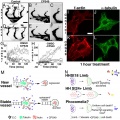File:Thalidomide - CPS49 vascular effect.jpg

Original file (1,000 × 1,002 pixels, file size: 197 KB, MIME type: image/jpeg)
CPS49 prevents filopodial extensions in endothelial cells
CPS49 - a tetrafluorinated analogue of thalidomide that is chemically and structurally related to thalidomide breakdown products.
(A–F) Confocal images of zebrafish intersomitic vessel (ISV) formation 3 h (A–C) or 6 h (D–F) after DMSO (A and D) or CPS49 (B, C, E, and F) treatment at 24 h postfertilization.
Black arrowheads in B and E are shown at higher power in C and F. CPS49 reduced the number of filopodia and filopodial extensions (arrowheads), stunted forming ISVs (black asterisk), and prevented formation of a patent, functional vascular network (black arrows; compare A, B, D, and E).
(G and H) Number of tip cell filopodia (G) and accumulative change in ISV length (H) in control (DMSO; open circles) and CPS49 (filled circles) treated zebrafish embryos imaged by using time-lapse photography.
(I–L) Confocal images of HUVEC cultured cells after 1 h of treatment with DMSO (I and J) or CPS49 (K and L). f-actin antibody staining highlights increased stress fibers in CPS49-treated cells (K) but not in DMSO-treated cells (I). alpha-tubulin staining indicates a decrease in tubulin structure between DMSO (J) and CPS49 (L) treated cells.
(M) Model of CPS49 action on endothelial cell and vessel outgrowth, where new vessel networks are stunted and lost as CPS49 prevents all angiogenesis, but in stable, established, mature networks, only the distal cell is prevented from angiogenesis and stunted temporarily.
(N) Model of action of CPS49 of the limb highlighting the developmental stage dependence of drug action. Treatment at HHst18 results in limb outgrowth failure, as all vessels are unstable and affected, whereas at HHst23, proximal vessels are stable, but distal vessels are angiogenic and lost resulting in loss of the handplate. We hypothesize that phocomelia arises because of some FGF signaling remaining, which can then pattern the resulting limb stump.
(Scale bars: A, B, D, and E, 25 μm; C and F, 12.5 μm; I–L, 10 μm; text modified from figure legend)
- Links: thalidomide
Reference
Therapontos C, Erskine L, Gardner ER, Figg WD & Vargesson N. (2009). Thalidomide induces limb defects by preventing angiogenic outgrowth during early limb formation. Proc. Natl. Acad. Sci. U.S.A. , 106, 8573-8. PMID: 19433787 DOI.
Copyright
Proceedings National Academy of Sciences (PNAS) Liberalization of PNAS copyright policy: Noncommercial use freely allowed Note original Author should be contacted for permission to reuse for Educational purposes. See also PNAS Author Rights and Permission FAQs
- Cozzarelli NR, Fulton KR, Sullenberger DM. Liberalization of PNAS copyright policy: noncommercial use freely allowed. Proc Natl Acad Sci U S A. 2004 Aug 24;101(34):12399. PMID15314225 "Our guiding principle is that, while PNAS retains copyright, anyone can make noncommercial use of work in PNAS without asking our permission, provided that the original source is cited."
Fig. 4. http://www.pnas.org/content/106/21/8573/F4.expansion.html
Cite this page: Hill, M.A. (2024, April 25) Embryology Thalidomide - CPS49 vascular effect.jpg. Retrieved from https://embryology.med.unsw.edu.au/embryology/index.php/File:Thalidomide_-_CPS49_vascular_effect.jpg
- © Dr Mark Hill 2024, UNSW Embryology ISBN: 978 0 7334 2609 4 - UNSW CRICOS Provider Code No. 00098G
File history
Click on a date/time to view the file as it appeared at that time.
| Date/Time | Thumbnail | Dimensions | User | Comment | |
|---|---|---|---|---|---|
| current | 13:05, 17 June 2010 |  | 1,000 × 1,002 (197 KB) | S8600021 (talk | contribs) | CPS49 prevents filopodial extensions in endothelial cells <ref><pubmed>19433787</pubmed></ref> CPS49 - a tetrafluorinated analogue of thalidomide that is chemically and structurally related to thalidomide breakdown products. (A–F) Confocal images of z |
You cannot overwrite this file.
File usage
The following page uses this file: